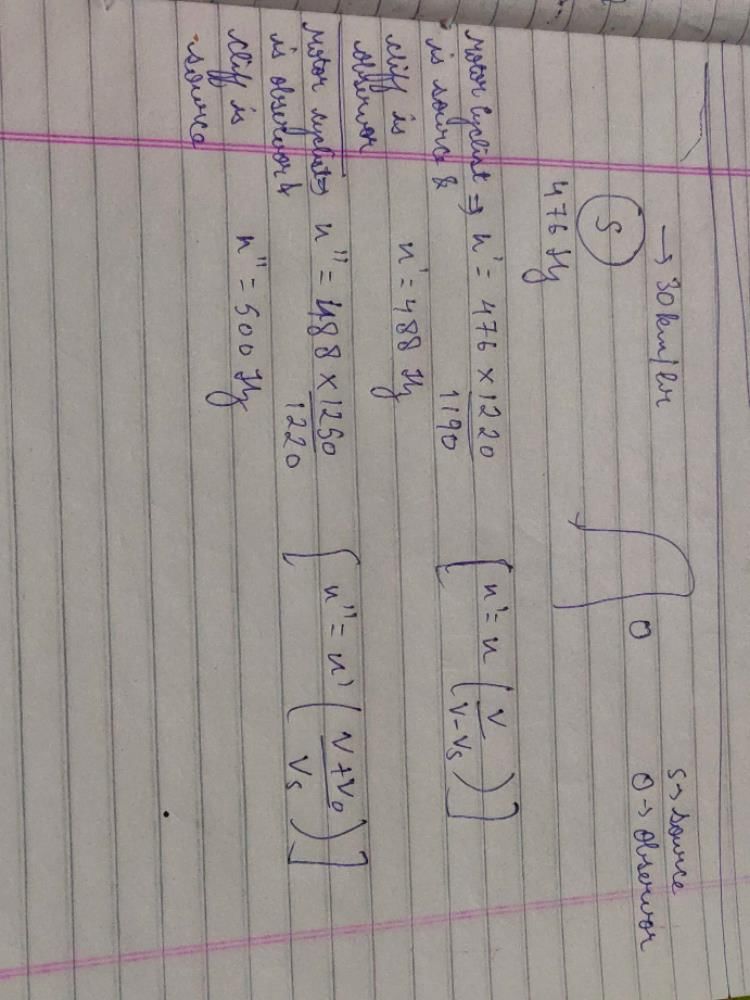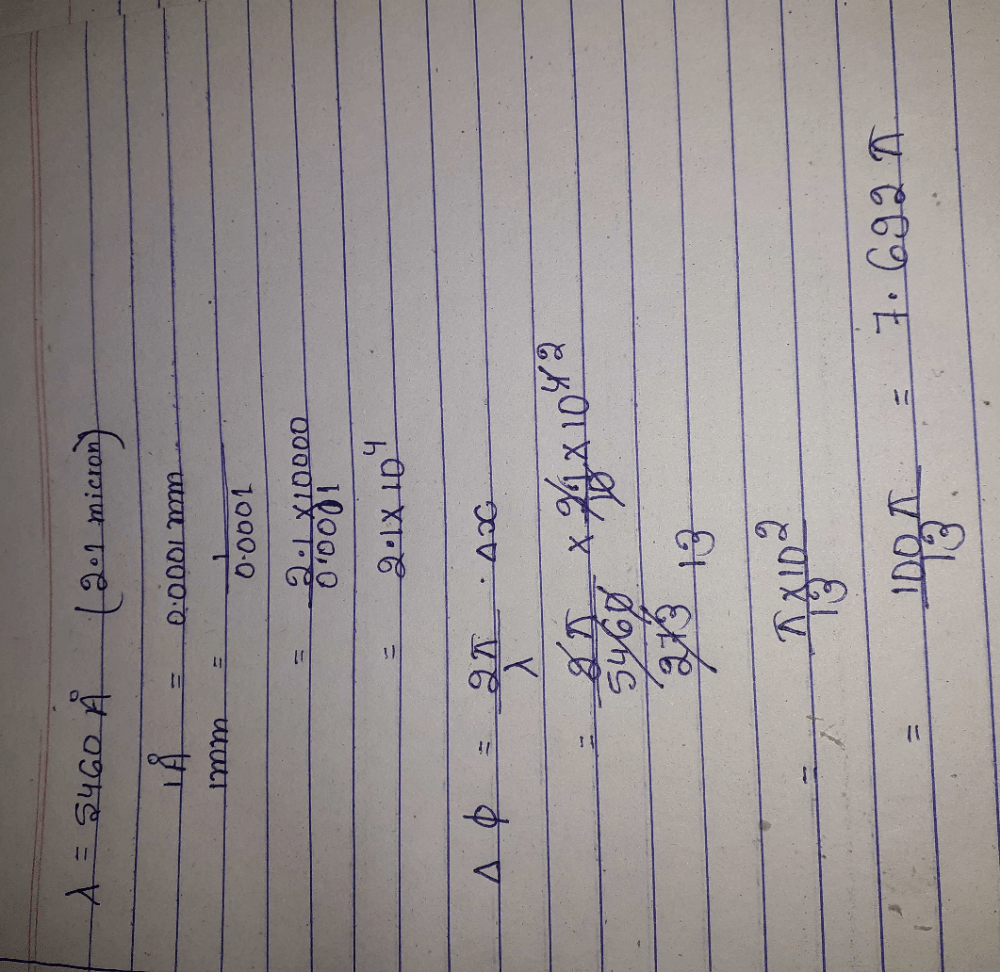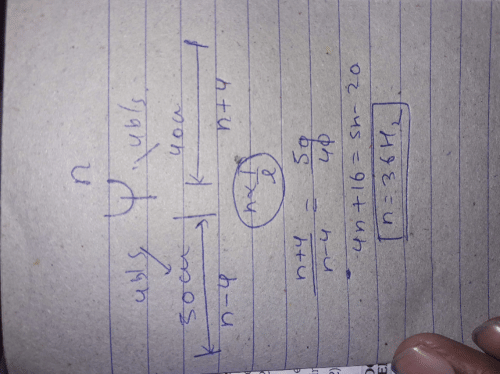All Exams >
JEE >
Chapter-wise Tests for JEE Main & Advanced >
All Questions
All questions of Wave Motion and Sound wave for JEE Exam
A sound source of frequency 600 Hz is moving towards an observer with velocity 20m/s. The speed of sound is 340m/s. The frequency heard by observer will be- a)630.5hz
- b)30hz
- c)637.5hz
- d)63.5 Hz
Correct answer is option 'C'. Can you explain this answer?
A sound source of frequency 600 Hz is moving towards an observer with velocity 20m/s. The speed of sound is 340m/s. The frequency heard by observer will be
a)
630.5hz
b)
30hz
c)
637.5hz
d)
63.5 Hz
|
|
Preeti Khanna answered |
F(s)/F(l) = [V+V(s)]/[V+V(l)]
V = velocity of sound = 340m/s
V(l) = velocity of listener = 0
F(l) = frequency heard by listener = ?
V(s) = velocity of source = -20m/s (because, it's source to listener)
F(s) = frequency of source = 600hz
By putting these values in the above formula and solving we get,
F(l) = 637.5 Hz.
Hence C is correct.
V = velocity of sound = 340m/s
V(l) = velocity of listener = 0
F(l) = frequency heard by listener = ?
V(s) = velocity of source = -20m/s (because, it's source to listener)
F(s) = frequency of source = 600hz
By putting these values in the above formula and solving we get,
F(l) = 637.5 Hz.
Hence C is correct.
A cylindrical tube, open at both ends, has a fundamental frequency f in air. The tube is dipped vertically in water so that half of it is in water. The fundamental frequency of the air-column is now:- a)f/2
- b)f
- c)2f
- d)3f/2
Correct answer is option 'B'. Can you explain this answer?
A cylindrical tube, open at both ends, has a fundamental frequency f in air. The tube is dipped vertically in water so that half of it is in water. The fundamental frequency of the air-column is now:
a)
f/2
b)
f
c)
2f
d)
3f/2
|
|
Krishna Iyer answered |
As we know, f=v/2l
Now, it will act as one end and one end closed.
So, f0=v/2l’=v/4½=v/2l=f
Now, it will act as one end and one end closed.
So, f0=v/2l’=v/4½=v/2l=f
Phenomenon of beats is not used in- a)Tuning musical instruments
- b)Detecting the presence of dangerous gases in mines
- c)Designing low frequency oscillators
- d)Radars for detecting submarines
Correct answer is option 'D'. Can you explain this answer?
Phenomenon of beats is not used in
a)
Tuning musical instruments
b)
Detecting the presence of dangerous gases in mines
c)
Designing low frequency oscillators
d)
Radars for detecting submarines

|
Top Rankers answered |
Radar uses electromagnetic energy pulses. The radio-frequency (rf) energy is transmitted to and reflected from the reflecting object. A small portion of the reflected energy returns to the radar set. This returned energy is called an ECHO. Radar sets use the echo to determine the direction and distance of the reflecting object.
It does not work on phenomena of beats.
It does not work on phenomena of beats.
As a wave propagates; which of the following is not satisfied?- a)the wave intensity remains constant for a plane wave
- b)total intensity of the spherical wave over the spherical surface centered at the source remains constant at all times
- c)the wave intensity decreases as the inverse of the square of the distance from the source for a spherical wave
- d)the wave intensity decreases as the inverse of the distance from the source for a spherical wave
Correct answer is option 'D'. Can you explain this answer?
As a wave propagates; which of the following is not satisfied?
a)
the wave intensity remains constant for a plane wave
b)
total intensity of the spherical wave over the spherical surface centered at the source remains constant at all times
c)
the wave intensity decreases as the inverse of the square of the distance from the source for a spherical wave
d)
the wave intensity decreases as the inverse of the distance from the source for a spherical wave
|
|
Shatabdi Malik answered |
I think it's ans is C.
Pure sound notes from two sources make the molecules of air at a location vibrate simple harmonically in accordance with the equations.
y1 = 0.008 sin (604 n t) and
y2 = 0.007 sin (610 n t) respectively.
The number of beast heard by a person at the location will be:- a)3
- b)1
- c)2
- d)4
Correct answer is option 'A'. Can you explain this answer?
Pure sound notes from two sources make the molecules of air at a location vibrate simple harmonically in accordance with the equations.
y1 = 0.008 sin (604 n t) and
y2 = 0.007 sin (610 n t) respectively.
The number of beast heard by a person at the location will be:
y1 = 0.008 sin (604 n t) and
y2 = 0.007 sin (610 n t) respectively.
The number of beast heard by a person at the location will be:
a)
3
b)
1
c)
2
d)
4

|
Tarun Kaushik answered |
Given that two sources produce pure sound notes as follows: y1= 0.008 sin (604 n t) y2= 0.007 sin (610 n t) To find the number of beats heard by a person at the location, we need to first understand the concept of beats.
Beats: When two sound waves of slightly different frequencies are superimposed, we hear a periodic variation in the loudness of sound. This variation is called beats.
The number of beats heard per second is given by the difference between the frequencies of the two sound waves.
Mathematically, the beat frequency is given by fbeat = |f1 - f2| where f1 and f2 are the frequencies of the two sound waves. In this problem, the frequencies of the two sound waves are 604 n and 610 n, respectively.
Therefore, the beat frequency is fbeat = |604 n - 610 n| = 6 n Since the beat frequency is 6 n, the number of beats heard per second is 6. Since each beat corresponds to two sound waves (one from each source), the total number of sound waves heard per second is twice the number of beats, which is 12.
However, the question asks for the number of distinct sounds heard, which is equal to the number of beats. Therefore, the answer is 3 (Option A).
An echo repeats two syllables. If the velocity of sound is 330 m/s, then the distance of reflecting surface is- a)16.5 m
- b)99 m
- c)66 m
- d)33.0 m
Correct answer is option 'C'. Can you explain this answer?
An echo repeats two syllables. If the velocity of sound is 330 m/s, then the distance of reflecting surface is
a)
16.5 m
b)
99 m
c)
66 m
d)
33.0 m
|
|
Rajesh Gupta answered |
Let us say that we speak syllables at a rate of 2 to 9 per second. So let us say that a syllable takes a minimum of 0.1 sec for a fast speaker. Let us say that a sound pulse (syllable) is emitted starting at t = 0.
The effect of a syllable lasts on the ear for 0.1 sec. So if any echo reaches the year before t = 0.2 sec., then it is mixed with the direct sound present in the ear and so echo is not properly heard.
In this problem, two syllables are repeated in the echo. That is it took about 2 * 0.2 sec ie., 0.4 seconds for the sound to travel to the reflecting surface and come back to the ear.
The distance of the reflecting surface from the person
= 330 m/s * 0.4 sec / 2
= 66 meters.
In an experiment to find the speed of waves in a rope, a standing wave pattern is established as shown in diagram below. The vibrating end of rope makes 90 vibrations per minute. The speed of the waves is

- a)4 m/s
- b)3 m/s
- c)6 m/s
- d)2 m/s
Correct answer is 'C'. Can you explain this answer?
In an experiment to find the speed of waves in a rope, a standing wave pattern is established as shown in diagram below. The vibrating end of rope makes 90 vibrations per minute. The speed of the waves is


a)
4 m/s
b)
3 m/s
c)
6 m/s
d)
2 m/s
|
|
Anjana Sharma answered |
90 vibrations in 60 seconds mans _frequency, f =1.5Hz
According to diagram1.5 Hz is covered in 6m wavelength, ω = 4m
We have qmed ,v = f x ω = 1.5 x 4 = 6m/s
A stationary observer receives sonic oscillations from two tuning forks, one of which approaches and the other recedes with same speed. As this takes place the observer hears the beat frequency of 2 Hz. Find the speed of each tuning fork,(assuming it is very small when compared to sound) if their oscillation frequency is 680 Hz and the velocity of sound in air is 340 m/s. - a)1 m/s
- b)2 m/s
- c)0.5 m/s
- d)1.5 m/s
Correct answer is option 'C'. Can you explain this answer?
A stationary observer receives sonic oscillations from two tuning forks, one of which approaches and the other recedes with same speed. As this takes place the observer hears the beat frequency of 2 Hz. Find the speed of each tuning fork,(assuming it is very small when compared to sound) if their oscillation frequency is 680 Hz and the velocity of sound in air is 340 m/s.
a)
1 m/s
b)
2 m/s
c)
0.5 m/s
d)
1.5 m/s
|
|
Lavanya Menon answered |
Let the frequencies be f1 and f2
So, f1 = f (vs/vs - v) and f2 = f (vs/vs + v)
ATQ: f1 – f2 = 2 Hz
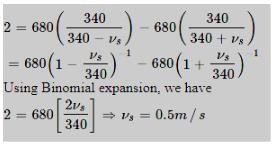
So, f1 = f (vs/vs - v) and f2 = f (vs/vs + v)
ATQ: f1 – f2 = 2 Hz

Fundamental note in open pipe (v1=ν/2L) has _________ the frequency of the fundamental note in closed organ pipe (v2=ν/4L).a)Twiceb)Halfc)Four timesd)ThriceCorrect answer is option 'A'. Can you explain this answer?
|
|
Riya Banerjee answered |
Let L be a length of the pipe,
The fundamental frequency of closed pipe is
v2=ν/4L .....(i)
where ν is the speed of sound in air.
Fundamental frequency of open pipe of same length is
v1=ν/2L .....(ii)
After dividing v1 with v2,
v1/v2= ν/2L/ ν/4L
v1=2v2
The fundamental frequency of closed pipe is
v2=ν/4L .....(i)
where ν is the speed of sound in air.
Fundamental frequency of open pipe of same length is
v1=ν/2L .....(ii)
After dividing v1 with v2,
v1/v2= ν/2L/ ν/4L
v1=2v2
When two tuning forks are sounded together 4 beats are heard per second. One tuning fork is of frequency 346 Hz. When its prong is loaded with a little wax, the number of beats is increased to 6 per second. The frequency of the other fork is:- a)352 Hz
- b)340 Hz
- c)350 Hz
- d)342 Hz
Correct answer is option 'C'. Can you explain this answer?
When two tuning forks are sounded together 4 beats are heard per second. One tuning fork is of frequency 346 Hz. When its prong is loaded with a little wax, the number of beats is increased to 6 per second. The frequency of the other fork is:
a)
352 Hz
b)
340 Hz
c)
350 Hz
d)
342 Hz
|
|
Suresh Reddy answered |
Frequency of fork one is 346 Hz.
When the other fork is waxed, the beat is increased.
So, the frequency of other fork is less than the frequency of fork one.
So,
beat = frequency of fork one − frequency of second fork
4=346− Frequency of second fork
Frequency of second fork =350 Hz
When the other fork is waxed, the beat is increased.
So, the frequency of other fork is less than the frequency of fork one.
So,
beat = frequency of fork one − frequency of second fork
4=346− Frequency of second fork
Frequency of second fork =350 Hz
A wave represented by the equation y = a cos (kx - ωt) is superposed with another wave to form a stationary wave such that point x = 0 is a node. The equation for the other wave is- a)a sin (kx +ωt)
- b)– a cos (kx - ωt)
- c)– a cos (kx + ωt)
- d)– a sin (kx - ωt)
Correct answer is option 'C'. Can you explain this answer?
A wave represented by the equation y = a cos (kx - ωt) is superposed with another wave to form a stationary wave such that point x = 0 is a node. The equation for the other wave is
a)
a sin (kx +ωt)
b)
– a cos (kx - ωt)
c)
– a cos (kx + ωt)
d)
– a sin (kx - ωt)
|
|
Hansa Sharma answered |
NOTE : Stationary wave is produced when two waves travel in opposite direction.
Now, y = a cos (kx – ωt) – a cos (kx + wt)
∴ y = 2a sin kx sin ωt is equation of stationary wave which gives a node at x = 0.
Now, y = a cos (kx – ωt) – a cos (kx + wt)
∴ y = 2a sin kx sin ωt is equation of stationary wave which gives a node at x = 0.
The speed of propagation of a sinusoidal wave is given by V=νλ where- a)ν is the reciprocal of the period and λ is the dispersion
- b)ν is the reciprocal of the period and λ is the wave number
- c)ν is the angular frequency and λ is the wavelength
- d)ν is the reciprocal of the period and λ is the wavelength
Correct answer is option 'D'. Can you explain this answer?
The speed of propagation of a sinusoidal wave is given by V=νλ where
a)
ν is the reciprocal of the period and λ is the dispersion
b)
ν is the reciprocal of the period and λ is the wave number
c)
ν is the angular frequency and λ is the wavelength
d)
ν is the reciprocal of the period and λ is the wavelength
|
|
Om Desai answered |
For a sinusoidal wave, V = v λ.
V = speed,
v = frequency,
λ = wavelength,
frequency (v) = reciprocal of the time period i.e. v =1/T
V = speed,
v = frequency,
λ = wavelength,
frequency (v) = reciprocal of the time period i.e. v =1/T
To the nearest order of magnitude, how many times greater than the speed of sound is the speed of light?- a)104
- b)1012
- c)108
- d)106
Correct answer is option 'D'. Can you explain this answer?
To the nearest order of magnitude, how many times greater than the speed of sound is the speed of light?
a)
104
b)
1012
c)
108
d)
106
|
|
Lavanya Menon answered |
Speed of sound in air is 343 m/s or we can say approx 300m/s
And speed of light is approx 300,000,000 m/s
Clearly the ratio is 106
And speed of light is approx 300,000,000 m/s
Clearly the ratio is 106
At t= 0, a transverse wave pulse travelling in the positive x direction with a speed of 2 m/s in a wire is described by the function y = 6/x2 given that x ≠ 0. Transverse velocity of a particle at x = 2 m and t = 2 s is - a)3 m/s
- b)-3 m/s
- c)8 m/s
- d)-8 m/s
Correct answer is option 'B'. Can you explain this answer?
At t= 0, a transverse wave pulse travelling in the positive x direction with a speed of 2 m/s in a wire is described by the function y = 6/x2 given that x ≠ 0. Transverse velocity of a particle at x = 2 m and t = 2 s is
a)
3 m/s
b)
-3 m/s
c)
8 m/s
d)
-8 m/s
|
|
Preeti Khanna answered |
Any transverse wave travelling in positive x-direction is of the form y = f (ax - bt) (and y = f (ax + bt) if it is travelling in negative x-direction) and has a wave speed equal to b/a.
Given a = 1 ⇒ b = 2
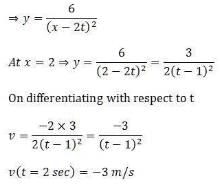
Given a = 1 ⇒ b = 2

Waves associated with moving protons, electrons, neutrons, atoms are known as- a)none of these
- b)Gamma rays
- c)Matter waves
- d)Electromagnetic waves
Correct answer is option 'C'. Can you explain this answer?
Waves associated with moving protons, electrons, neutrons, atoms are known as
a)
none of these
b)
Gamma rays
c)
Matter waves
d)
Electromagnetic waves

|
Vik. Singh answered |
If they are associated with matter waves then what about electromagnetic waves..?
... I'm so confused now :(
A piano wire having a diameter of 0.90 mm is replaced by another wire of the same length and material but with a diameter of 0.93 mm. If the tension of the wire is kept the same, then the percentage change in the frequency of the fundamental tone is nearly - a)+3%
- b)+3.3 %
- c)-3.3%
- d)-3%
Correct answer is option 'C'. Can you explain this answer?
A piano wire having a diameter of 0.90 mm is replaced by another wire of the same length and material but with a diameter of 0.93 mm. If the tension of the wire is kept the same, then the percentage change in the frequency of the fundamental tone is nearly
a)
+3%
b)
+3.3 %
c)
-3.3%
d)
-3%
|
|
Preeti Iyer answered |
Out of all the given quantities only frequency of the wire "f” and radius of the wire "R" changes and the remaining doesn't. Also if a quantity doesn't change (or is a constant) its derivative is zero. Given, initial radius = 0.45 mm and final radius = 0.465 mm so change in radius, ΔR = 0.015 mm
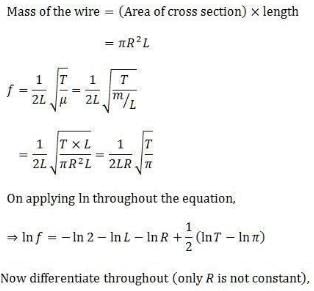
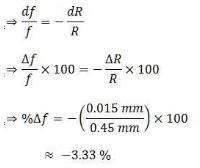


Velocity of sound in air is 300 m/s. Then the distance between two successive nodes of a stationary wave of frequency 1000 Hz is.- a)20cm
- b)15 cm
- c)30cm
- d)10 cm
Correct answer is option 'B'. Can you explain this answer?
Velocity of sound in air is 300 m/s. Then the distance between two successive nodes of a stationary wave of frequency 1000 Hz is.
a)
20cm
b)
15 cm
c)
30cm
d)
10 cm
|
|
Raghav Bansal answered |
Velocity of sound in air= 300m/s =300×100=30000 cm/s
And frequency = 1000 hz
So, wavelength = Velocity/frequency
= 30000/1000= 30
Distance = wavelength/2
=30/2 = 15
And frequency = 1000 hz
So, wavelength = Velocity/frequency
= 30000/1000= 30
Distance = wavelength/2
=30/2 = 15
A 100 m long rod of density 10.0 x 104 kg/m3 and having Young’s modules Y = 1011 Pa, is clamped at one end. It is hammered at the other free end. The longitudinal pulse goes to right end, gets reflected and again returns to the left end. How much time, the pulse take to go back to initial point.
- a)0.1 sec
- b)0.2 sec
- c)0.3 sec
- d)2 sec
Correct answer is option 'B'. Can you explain this answer?
A 100 m long rod of density 10.0 x 104 kg/m3 and having Young’s modules Y = 1011 Pa, is clamped at one end. It is hammered at the other free end. The longitudinal pulse goes to right end, gets reflected and again returns to the left end. How much time, the pulse take to go back to initial point.
a)
0.1 sec
b)
0.2 sec
c)
0.3 sec
d)
2 sec
|
|
Rajesh Gupta answered |
The velocity of a wave in any rod is given by,
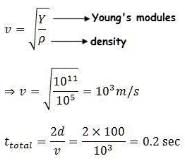
Note that we should take twice the length of the rod since we want time take by the wave to return back to the initial point.

Note that we should take twice the length of the rod since we want time take by the wave to return back to the initial point.
If a source of sound was moving toward a receiver at 1/3 the speed of sound, what would the resulting wavelength be?- a)6 times the emitted wavelength
- b)2/3 of the emitted wavelength
- c)1/3 of the emitted wavelength
- d)Can not be found
Correct answer is option 'B'. Can you explain this answer?
If a source of sound was moving toward a receiver at 1/3 the speed of sound, what would the resulting wavelength be?
a)
6 times the emitted wavelength
b)
2/3 of the emitted wavelength
c)
1/3 of the emitted wavelength
d)
Can not be found

|
Ambition Institute answered |
We need to find the resulting wavelength of the sound wave, which can be calculated using the formula: λ' = λ(v +/- vs) / (v + u) Since the source is moving towards the observer, we can use the negative sign for vs: λ' = λ(v - vs) / (v + u) λ' = λ(v - (-1/3)v) / (v + u) λ' = λ(4/3v) / (v + u) We can also use the formula for the speed of the sound wave: v = fλ which gives us: λ = v/f Substituting this value in the above equation, we get: λ' = (4/3)(v/f) / (v + u) λ' = (4/3)f / (3v + u) We know that the velocity of the observer (u) is zero since it is stationary. Thus, the equation simplifies to: λ' = (4/9)f/v This means that the resulting wavelength is 2/3 of the emitted wavelength since: λ' / λ = (4/9f/v) / (f/v) = 4/9 = 0.44 Therefore, the correct answer is option B, 2/3 of the emitted wavelength.
A tuning fork arrangement (pair) produces 4 beats/sec with one fork of frequency 288 cps. A little wax is placed on the unknown fork and it then produces 2 beats/sec. The frequency of the unknown fork is- a)286 cps
- b)292 cps
- c)294 cps
- d) 288 cps.
Correct answer is option 'B'. Can you explain this answer?
A tuning fork arrangement (pair) produces 4 beats/sec with one fork of frequency 288 cps. A little wax is placed on the unknown fork and it then produces 2 beats/sec. The frequency of the unknown fork is
a)
286 cps
b)
292 cps
c)
294 cps
d)
288 cps.

|
Athul Patel answered |
A tuning fork produces 4 beats/sec with another tuning fork of frequency 288 cps. From this information we can conclude that the frequency of unknown fork is 288 + 4 cps or 288 – 4 cps i.e. 292 cps or 284 cps. When a little wax is placed on the unknown fork, it produces 2 beats/sec. When a little wax is placed on the unknown fork, its frequency decreases and simultaneously the beat frequency decreases confirming that the frequency of the unknown fork is 292 cps.
A fork of unknown frequency when sounded with another fork of frequency 256 Hz produces 4 beats/sec. The first fork is loaded with wax. It again produces 4 beats/sec. When sounded together with the fork of 256 Hz frequency, then the frequency of first tuning fork is- a)252 Hz
- b)260Hz
- c)None of these
- d)252 or 260 Hz
Correct answer is option 'B'. Can you explain this answer?
A fork of unknown frequency when sounded with another fork of frequency 256 Hz produces 4 beats/sec. The first fork is loaded with wax. It again produces 4 beats/sec. When sounded together with the fork of 256 Hz frequency, then the frequency of first tuning fork is
a)
252 Hz
b)
260Hz
c)
None of these
d)
252 or 260 Hz
|
|
Raghav Bansal answered |
After waxing the frequency of the tuning fork decreases and so the initial frequency must be higher so as to decrease it below 256 Hz in order to give 4 beats/sec.
The necessary condition for phenomenon of interference to occur is- a)There should be two coherent sources.
- b)The frequency and amplitude of both the waves should be same
- c)The propagation of waves should be simultaneously and in same direction
- d)All of the above
Correct answer is option 'D'. Can you explain this answer?
The necessary condition for phenomenon of interference to occur is
a)
There should be two coherent sources.
b)
The frequency and amplitude of both the waves should be same
c)
The propagation of waves should be simultaneously and in same direction
d)
All of the above
|
|
Neha Joshi answered |
The necessary condition for phenomenon of interference to occur are:
1. There should be two coherent sources.
2. The frequency and amplitude of both the waves should be same.
3. The propagation of waves should be simultaneously and in same direction.
These are the conditions, no explanation.
1. There should be two coherent sources.
2. The frequency and amplitude of both the waves should be same.
3. The propagation of waves should be simultaneously and in same direction.
These are the conditions, no explanation.
Two harmonic waves traveling on a string in the same direction both have a frequency of 100 Hz, a wavelenqth of 2.0cm, and amplitude of 0.020 m. In addition, they overlap each other. What is the amplitude of the resultant wave if the original waves differ in phase by Syntax error from line 1 column 49 to line 1 column 73. Unexpected ‘mathsize’./6?- a)3.5 cm
- b)4.2 cm
- c)3.7 cm
- d)3.9 cm
Correct answer is option 'D'. Can you explain this answer?
Two harmonic waves traveling on a string in the same direction both have a frequency of 100 Hz, a wavelenqth of 2.0cm, and amplitude of 0.020 m. In addition, they overlap each other. What is the amplitude of the resultant wave if the original waves differ in phase by Syntax error from line 1 column 49 to line 1 column 73. Unexpected ‘mathsize’./6?
a)
3.5 cm
b)
4.2 cm
c)
3.7 cm
d)
3.9 cm
|
|
Rajeev Nair answered |
Question:
Two harmonic waves traveling on a string in the same direction both have a frequency of 100 Hz, a wavelength of 2.0 cm, and amplitude of 0.020 m. In addition, they overlap each other. What is the amplitude of the resultant wave if the original waves differ in phase by 6π?
Solution:
Given parameters:
Frequency of each wave = 100 Hz
Wavelength of each wave = 2.0 cm
Amplitude of each wave = 0.020 m
Phase difference between the waves = 6π
To find: Amplitude of the resultant wave
We know that the displacement of a wave is given by the equation:
y = A sin(kx - ωt + φ)
where, A = amplitude of the wave, k = wave number, x = position, ω = angular frequency, t = time, and φ = phase constant.
For two waves with the same frequency and wavelength traveling in the same direction, the wave number and angular frequency are the same, and the displacement equation becomes:
y1 = A sin(kx - ωt + φ1)
y2 = A sin(kx - ωt + φ2)
where, φ1 and φ2 are the phase constants of the two waves.
The resultant wave is obtained by adding the two waves:
y = y1 + y2
= A sin(kx - ωt + φ1) + A sin(kx - ωt + φ2)
= 2A cos((φ1 - φ2)/2) sin(kx - ωt + (φ1 + φ2)/2)
where, cos((φ1 - φ2)/2) is the amplitude of the resultant wave.
Given that the phase difference between the waves is 6π, we have:
φ1 - φ2 = 6π
cos((φ1 - φ2)/2) = cos(3π) = -1
Substituting the given values, we get:
Amplitude of the resultant wave = 2(0.020) (-1) = -0.040 m
However, amplitude is always positive, so we take the absolute value:
Amplitude of the resultant wave = 0.040 m
Therefore, the amplitude of the resultant wave is 0.040 m.
Two harmonic waves traveling on a string in the same direction both have a frequency of 100 Hz, a wavelength of 2.0 cm, and amplitude of 0.020 m. In addition, they overlap each other. What is the amplitude of the resultant wave if the original waves differ in phase by 6π?
Solution:
Given parameters:
Frequency of each wave = 100 Hz
Wavelength of each wave = 2.0 cm
Amplitude of each wave = 0.020 m
Phase difference between the waves = 6π
To find: Amplitude of the resultant wave
We know that the displacement of a wave is given by the equation:
y = A sin(kx - ωt + φ)
where, A = amplitude of the wave, k = wave number, x = position, ω = angular frequency, t = time, and φ = phase constant.
For two waves with the same frequency and wavelength traveling in the same direction, the wave number and angular frequency are the same, and the displacement equation becomes:
y1 = A sin(kx - ωt + φ1)
y2 = A sin(kx - ωt + φ2)
where, φ1 and φ2 are the phase constants of the two waves.
The resultant wave is obtained by adding the two waves:
y = y1 + y2
= A sin(kx - ωt + φ1) + A sin(kx - ωt + φ2)
= 2A cos((φ1 - φ2)/2) sin(kx - ωt + (φ1 + φ2)/2)
where, cos((φ1 - φ2)/2) is the amplitude of the resultant wave.
Given that the phase difference between the waves is 6π, we have:
φ1 - φ2 = 6π
cos((φ1 - φ2)/2) = cos(3π) = -1
Substituting the given values, we get:
Amplitude of the resultant wave = 2(0.020) (-1) = -0.040 m
However, amplitude is always positive, so we take the absolute value:
Amplitude of the resultant wave = 0.040 m
Therefore, the amplitude of the resultant wave is 0.040 m.
In an interference arrangement similar to Young's double-slit experiment, the slits S1 & S2 are illuminated with coherent microwave sources, each of frequency 106 Hz. The sources are synchronized to have zero phase difference. The slits are separated by a distance d = 150.0 m. The intensity I(q) is measured as a function of q, where q is defined as shown. If I0 is the maximum intensity then I(q) for 0 £ q £ 90° is given by 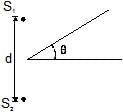
- a) I(q) =
 for q = 30º
for q = 30º - b)I(q) =
 for q = 90º
for q = 90º - c) I(q) = I0 for q = 0º
- d)I(q) is constant for all values of q
Correct answer is option 'A,C'. Can you explain this answer?
In an interference arrangement similar to Young's double-slit experiment, the slits S1 & S2 are illuminated with coherent microwave sources, each of frequency 106 Hz. The sources are synchronized to have zero phase difference. The slits are separated by a distance d = 150.0 m. The intensity I(q) is measured as a function of q, where q is defined as shown. If I0 is the maximum intensity then I(q) for 0 £ q £ 90° is given by
a)
I(q) =  for q = 30º
for q = 30º
b)
I(q) =  for q = 90º
for q = 90º
c)
I(q) = I0 for q = 0º
d)
I(q) is constant for all values of q

|
Lohit Matani answered |
I=I0cos2(πdtanθ/ λ)/
= I0cos2(πx150xtanθ/3x(108/106)
=I0cos2(πtanθ/2)
θ=30o
I= I0cos2 ((π/2√3)
I=I0/2
θ=0
I=I0cos2(0) [cos0=1]
I= I0
= I0cos2(πx150xtanθ/3x(108/106)
=I0cos2(πtanθ/2)
θ=30o
I= I0cos2 ((π/2√3)
I=I0/2
θ=0
I=I0cos2(0) [cos0=1]
I= I0
In Doppler effect change in frequency depends on- a)distance between source and listener
- b)speeds of source and listener
- c)density of air
- d)half of distance between source and listener
Correct answer is option 'B'. Can you explain this answer?
In Doppler effect change in frequency depends on
a)
distance between source and listener
b)
speeds of source and listener
c)
density of air
d)
half of distance between source and listener
|
|
Om Desai answered |
The reason for the Doppler effect is that when the source of the waves is moving towards the observer, each successive wave crest is emitted from a position closer to the observer than the crest of the previous wave.
A radar sends a radio signal of frequency 9 x 109 Hz towards an aircraft approaching the radar. If the reflected wave shows a frequency shift of 3 X 103 Hz, the speed with which the aircraft is approaching the radar in m/s is (velocity of radio signal is 3 X 108 m/s).- a)100
- b)150
- c)50
- d)25
Correct answer is option 'C'. Can you explain this answer?
A radar sends a radio signal of frequency 9 x 109 Hz towards an aircraft approaching the radar. If the reflected wave shows a frequency shift of 3 X 103 Hz, the speed with which the aircraft is approaching the radar in m/s is (velocity of radio signal is 3 X 108 m/s).
a)
100
b)
150
c)
50
d)
25
|
|
Rajesh Gupta answered |
Given:
Frequency of radio signal n=9×10 9Hz
Frequency shift n0=3×103Hz
Velocity of radio signal v=3×108m/s
Frequency shift shown by reflected wave is Shift =n−n
=>n−n=(v+u/v−u)n−n
Shift=(2u/v−u)n
Now, putting the given values in Eq. (i), we get,
3×103=(2u/3×10-8−u)9×109
⇒3×108−u=2u×9×109/3×103
=6u×106
⇒6×106u+u=3×108
u(6×106+1)=3×108
u(6000001)=3×108
u=3×108/6000001=49.999≈50m/s
Frequency of radio signal n=9×10 9Hz
Frequency shift n0=3×103Hz
Velocity of radio signal v=3×108m/s
Frequency shift shown by reflected wave is Shift =n−n
=>n−n=(v+u/v−u)n−n
Shift=(2u/v−u)n
Now, putting the given values in Eq. (i), we get,
3×103=(2u/3×10-8−u)9×109
⇒3×108−u=2u×9×109/3×103
=6u×106
⇒6×106u+u=3×108
u(6×106+1)=3×108
u(6000001)=3×108
u=3×108/6000001=49.999≈50m/s
If the source of sound moves at the same speed or faster than speed of the wave then it results in- a)Doppler effect
- b)Beats
- c)Shock waves
- d)Refraction of sound
Correct answer is option 'C'. Can you explain this answer?
If the source of sound moves at the same speed or faster than speed of the wave then it results in
a)
Doppler effect
b)
Beats
c)
Shock waves
d)
Refraction of sound
|
|
Lavanya Menon answered |
The Doppler Effect is observed whenever the speed of the source is moving slower than the speed of waves. But if the source actually moves at the same speed as or faster than the waves, a different phenomenon is observed. This phenomenon is known as Shock waves or Sonic Booms.
A sinusoidal wave is generated by moving the end of a string up and down, periodically. The generator must apply the energy at maximum rate when the end of the string attached to generator has X and least power when the end of the string attached to generator has Y. The most suitable option which correctly fills blanks X and Y, is - a)Maximum displacement, least acceleration
- b)maximum displacement, maximum acceleration
- c)Least displacement, maximum acceleration
- d)Least displacement, least acceleration
Correct answer is option 'C'. Can you explain this answer?
A sinusoidal wave is generated by moving the end of a string up and down, periodically. The generator must apply the energy at maximum rate when the end of the string attached to generator has X and least power when the end of the string attached to generator has Y. The most suitable option which correctly fills blanks X and Y, is
a)
Maximum displacement, least acceleration
b)
maximum displacement, maximum acceleration
c)
Least displacement, maximum acceleration
d)
Least displacement, least acceleration

|
Juhi Iyer answered |
Power for a travelling wave on a string is given by
For the displacement wave, y = A sin (kx – ωt)
Power delivered is maximum when cos2(kx – ωt) is maximum, which would be the case when sin (kx – ωt) is the least, i.e., displacement is minimum (acceleration is minimum). Power delivered is minimum when cos2(kx – ωt) is minimum, which would be when sin(kx - cos2(kx – ωt)t) is maximum, i.e displacement is maximum(acceleration is maximum).
A node is a point where there is always- a)Constructive interference
- b)Destructive interference
- c)Double trough
- d)Two crests
Correct answer is option 'B'. Can you explain this answer?
A node is a point where there is always
a)
Constructive interference
b)
Destructive interference
c)
Double trough
d)
Two crests
|
|
Preeti Iyer answered |
A node is a point along the medium of no displacement. The point is not displaced because destructive interference occurs at this point.
A beam of light consisting of two wavelengths 6500 Å and 5200 Å is used to obtain interference fringes in Young's double slit experiment. The distance between slits is 2mm and the distance of screen from slits is 120 cm. What is the least distance from central maximum where the bright due to both wavelength coincide ?- a)0.156 cm
- b)0.312 cm
- c)0.078 cm
- d)0.468 cm
Correct answer is option 'A'. Can you explain this answer?
A beam of light consisting of two wavelengths 6500 Å and 5200 Å is used to obtain interference fringes in Young's double slit experiment. The distance between slits is 2mm and the distance of screen from slits is 120 cm. What is the least distance from central maximum where the bright due to both wavelength coincide ?
a)
0.156 cm
b)
0.312 cm
c)
0.078 cm
d)
0.468 cm
|
|
Gaurav Kumar answered |
If n is least number of fringes of λ1(=6500A∘) which are coincident with (n+1) of smaller wavelength

also β=λD/d
substituting values for wavelength,D and d we get β = 0.039cm
So,
Hence b is the correct answer.

also β=λD/d
substituting values for wavelength,D and d we get β = 0.039cm
So,

Hence b is the correct answer.
Two sound sources fixed at a given distance apart are emitting sound each of wavelength λ. A Listener moves with a velocity v0 along the line joining the two sources , the number of beats heard by him per second is- a)4v0/λ
- b)v0/3λ
- c)v0/2λ
- d)2v0/λ
Correct answer is option 'D'. Can you explain this answer?
Two sound sources fixed at a given distance apart are emitting sound each of wavelength λ. A Listener moves with a velocity v0 along the line joining the two sources , the number of beats heard by him per second is
a)
4v0/λ
b)
v0/3λ
c)
v0/2λ
d)
2v0/λ

|
Jasvir Special answered |
A
Two trains A and B approach a station from opposite sides, sounding their whistles. A stationary observer on the platform hears no beats. If the velocities of A and B are 15 m/s and 30 m/s respectively and the real frequency of the whistle of B is 600 Hz, the real frequency of the whistle of A is (Velocity of sound = 330 m/s).- a)660 Hz
- b)600 Hz
- c)570 Hz
- d)630 Hz
Correct answer is option 'D'. Can you explain this answer?
Two trains A and B approach a station from opposite sides, sounding their whistles. A stationary observer on the platform hears no beats. If the velocities of A and B are 15 m/s and 30 m/s respectively and the real frequency of the whistle of B is 600 Hz, the real frequency of the whistle of A is (Velocity of sound = 330 m/s).
a)
660 Hz
b)
600 Hz
c)
570 Hz
d)
630 Hz
|
|
Preeti Iyer answered |
When no beats is listened at the station thus we get the relative frequencies of both the trains are the same.
Hence the relative frequency of the train B is 600 (330/300) = 660
similarly the relative frequency of train A is f(330/315) = 660
Hence we get f = 630Hz
Hence the relative frequency of the train B is 600 (330/300) = 660
similarly the relative frequency of train A is f(330/315) = 660
Hence we get f = 630Hz
Time interval between two successive maxima of sound waves with frequencies v1 and v2 is given by- a)v1/v2
- b)1/ (v1 - v2)
- c)v1 = v2 = 0
- d)v1 - v2
Correct answer is option 'B'. Can you explain this answer?
Time interval between two successive maxima of sound waves with frequencies v1 and v2 is given by
a)
v1/v2
b)
1/ (v1 - v2)
c)
v1 = v2 = 0
d)
v1 - v2
|
|
Nandini Iyer answered |
As we know time interval will have dimensions of time so check in option for dimension of time.
Dimensions of v is "per second" or [T-1]
Dimensions of v is "per second" or [T-1]
In a standard YDSE appratus a thin film (m = 1.5, t = 2.1 mm) is placed in front of upper slit. How far above or below the centre point of the screen are two nearest maxima located ? Take D = 1 m, d = 1mm, l = 4500 Å. (Symbols have usual meaning)- a) 1.5 mm (
- b)0.6 mm
- c)0.15 mm
- d)0.3 mm
Correct answer is option 'C,D'. Can you explain this answer?
In a standard YDSE appratus a thin film (m = 1.5, t = 2.1 mm) is placed in front of upper slit. How far above or below the centre point of the screen are two nearest maxima located ? Take D = 1 m, d = 1mm, l = 4500 Å. (Symbols have usual meaning)
a)
1.5 mm (
b)
0.6 mm
c)
0.15 mm
d)
0.3 mm
|
|
Geetika Shah answered |

There are three sources of sound of equal intensities with frequencies 400, 401 and 402 Hz. The number of beats per seconds is- a)3
- b)1.0
- c)0
- d)2
Correct answer is option 'B'. Can you explain this answer?
There are three sources of sound of equal intensities with frequencies 400, 401 and 402 Hz. The number of beats per seconds is
a)
3
b)
1.0
c)
0
d)
2
|
|
Hansa Sharma answered |
Resultant displacement of the wave by these three wave is
y=asin2π400t+asin2π401t+asin2π402t
y=a(1+2cos2πt)sin2π401t
So the resultant magnitude a(1+2cos2πt) has a maximum when,
cos2πt=1
or, t=0,1,2...
The time interval between two successive maximum is 1 sec.
So beat frequency is 1sec.
y=asin2π400t+asin2π401t+asin2π402t
y=a(1+2cos2πt)sin2π401t
So the resultant magnitude a(1+2cos2πt) has a maximum when,
cos2πt=1
or, t=0,1,2...
The time interval between two successive maximum is 1 sec.
So beat frequency is 1sec.
Maximum destructive inference between two waves occurs when the waves are out of the phase by- a)π/2radians
- b)π radians
- c)π/3 radians
- d)π/4 radians
Correct answer is option 'B'. Can you explain this answer?
Maximum destructive inference between two waves occurs when the waves are out of the phase by
a)
π/2radians
b)
π radians
c)
π/3 radians
d)
π/4 radians
|
|
Anjali Iyer answered |
Destructive interference occurs when the maxima of two waves are 180 degrees out of phase: a positive displacement of one wave is cancelled exactly by a negative displacement of the other wave. The amplitude of the resulting wave is zero. ... The dark regions occur whenever the waves destructively interfere.
Doppler’s effect in sound is:- a)Superimposing
- b)Asymmetrical
- c)Infinite
- d)Symmetrical
Correct answer is option 'B'. Can you explain this answer?
Doppler’s effect in sound is:
a)
Superimposing
b)
Asymmetrical
c)
Infinite
d)
Symmetrical

|
Ramesh Chand answered |
Sound wave require a material medium for their propagation. Therefore we say that the Doppler effect in sound is asymmetric. Hence option B is the right answer.
A whistle producing sound waves of frequencies 9500 Hz and above is approaching a stationary person with speed v ms-1. The velocity of sound in air is 300 ms-1. If the person can hear frequencies up to 10000 Hz, the maximum value of v upto which he can the whistle is- a)30√2 ms-1
- b)15 ms-1
- c)15/√2 ms-1
- d)30 ms-1
Correct answer is option 'B'. Can you explain this answer?
A whistle producing sound waves of frequencies 9500 Hz and above is approaching a stationary person with speed v ms-1. The velocity of sound in air is 300 ms-1. If the person can hear frequencies up to 10000 Hz, the maximum value of v upto which he can the whistle is
a)
30√2 ms-1
b)
15 ms-1
c)
15/√2 ms-1
d)
30 ms-1
|
|
Rohan Singh answered |

Two trains A and B moving with speeds 20 m/s and 30 m/s respectively in the same direction on the same straight track, with B ahead of A. The engines are at the front ends. The engine of train A blows a long whistle.
Assume that the sound of the whistle is composed of components varying in frequency from f1 = 800 Hz to f2 = 1120 Hz, as shown in the figure. The spread in the frequency (highest frequency – lowest frequency) is thus 320 Hz. The speed of sound in still air is 340 m/s.Q. The speed of sound of the whistle is- a)340 m/s for passengers in A and 310 m/s for passengers in B
- b)360 m/s for passengers in A and 310 m/s for passengers in B
- c)310 m/s for passengers in A and 360 m/s for passengers in B
- d)340 m/s for passengers in both the trains
Correct answer is option 'B'. Can you explain this answer?
Two trains A and B moving with speeds 20 m/s and 30 m/s respectively in the same direction on the same straight track, with B ahead of A. The engines are at the front ends. The engine of train A blows a long whistle.
Assume that the sound of the whistle is composed of components varying in frequency from f1 = 800 Hz to f2 = 1120 Hz, as shown in the figure. The spread in the frequency (highest frequency – lowest frequency) is thus 320 Hz. The speed of sound in still air is 340 m/s.
Assume that the sound of the whistle is composed of components varying in frequency from f1 = 800 Hz to f2 = 1120 Hz, as shown in the figure. The spread in the frequency (highest frequency – lowest frequency) is thus 320 Hz. The speed of sound in still air is 340 m/s.
Q. The speed of sound of the whistle is
a)
340 m/s for passengers in A and 310 m/s for passengers in B
b)
360 m/s for passengers in A and 310 m/s for passengers in B
c)
310 m/s for passengers in A and 360 m/s for passengers in B
d)
340 m/s for passengers in both the trains

|
Pragati Dey answered |
The speed of sound depends on the frame of reference of the observer.
A conveyor belt moves to the right with speed v=300 m/min. A pieman puts pies on the belt at a rate of 20 per minute while walking with speed 30 m/min towards a receiver at the other end. The frequency with which they are received by the stationary receiver is : - a)26.67 / minute
- b)30 / minute
- c)22.22/minute
- d)24 / minute
Correct answer is option 'C'. Can you explain this answer?
A conveyor belt moves to the right with speed v=300 m/min. A pieman puts pies on the belt at a rate of 20 per minute while walking with speed 30 m/min towards a receiver at the other end. The frequency with which they are received by the stationary receiver is :
a)
26.67 / minute
b)
30 / minute
c)
22.22/minute
d)
24 / minute

|
Nandini Chakraborty answered |
This problem is a Doppler effect analogy
Where f = 20/min , v= 300 m/min
And vs = 30 m / min
Chapter doubts & questions for Wave Motion and Sound wave - Chapter-wise Tests for JEE Main & Advanced 2025 is part of JEE exam preparation. The chapters have been prepared according to the JEE exam syllabus. The Chapter doubts & questions, notes, tests & MCQs are made for JEE 2025 Exam. Find important definitions, questions, notes, meanings, examples, exercises, MCQs and online tests here.
Chapter doubts & questions of Wave Motion and Sound wave - Chapter-wise Tests for JEE Main & Advanced in English & Hindi are available as part of JEE exam.
Download more important topics, notes, lectures and mock test series for JEE Exam by signing up for free.

Contact Support
Our team is online on weekdays between 10 AM - 7 PM
Typical reply within 3 hours
|
Free Exam Preparation
at your Fingertips!
Access Free Study Material - Test Series, Structured Courses, Free Videos & Study Notes and Prepare for Your Exam With Ease

 Join the 10M+ students on EduRev
Join the 10M+ students on EduRev
|

|
Create your account for free
OR
Forgot Password
OR
Signup to see your scores
go up
within 7 days!
within 7 days!
Takes less than 10 seconds to signup




